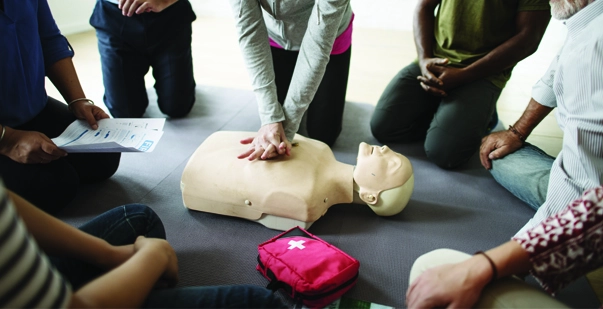
Last Updated On: octubre 17, 2024
In the healthcare world, CPR training is like a superhero skill—it can save lives when seconds count. However, not everyone in healthcare needs to be an expert in CPR. So, knowing who should learn it and who might not need to can help hospitals and clinics use their resources very wisely and keep their patients safe.
Some healthcare roles are directly involved in patient care and need CPR for healthcare providers’ training, while some others might not use it very often. So, by figuring out who really benefits from CPR training in healthcare, we can make sure that everyone is actually prepared for emergencies where it counts.
Now, let’s learn and take a deep dive into who needs CPR training and who might not need it in today’s healthcare world.
Finding out who needs CPR training in healthcare is the most important thing because this ensures the safety of the patient and leads to an effective emergency response within medical settings.
Clinical Staff:
Healthcare professionals who are directly involved in patient care, such as doctors, nurses, and paramedics, require comprehensive CPR training to respond in a prompt manner during emergencies and easily give life-saving assistance.
Non-Clinical Staff:
Although they are not directly involved in patient care, administrative staff, technicians, and other non-clinical roles also benefit from CPR training. They can then ensure a safe environment and support their clinical staff during emergencies.
Special Cases:
Here in special cases and certain situations, such as outpatient facilities, dental offices, and rehabilitation centers there may not be seen as a very frequent medical emergency but still, it requires staff to be prepared with CPR skills to take care of unexpected events.
Volunteers and Visitors:
In many healthcare settings, volunteers and visitors can also encounter emergencies where CPR skills can prove to be invaluable. So, giving them CPR training enhances overall readiness and leads to a coordinated response in critical situations.
CPR training is invaluable in healthcare settings because it always empowers individuals with life-saving skills in times of emergencies.
Clinical Staff Readiness:
These include Doctors, nurses, and paramedics who require CPR training to respond effectively during crises because this will help save lives with their immediate actions.
Non-Clinical Staff Preparedness:
Be it the administrative or the support staff, although they are not directly involved in patient care anyways they do benefit from CPR training and better the overall facility safety.
Visitor and Volunteer Empowerment:
Providing CPR skills to visitors and volunteers expands the facility’s emergency response capacity which then leads to creating a safer environment for everybody.
Leadership’s Role in Safety:
By taking up CPR training and advocating its importance, leaders establish safety standards and therefore encourage a culture of preparedness.
Community-wide Impact:
CPR training in healthcare facilities enhances internal response capabilities. It actually contributes to a stronger healthcare system thus benefiting the broader community.
While CPR training is always associated with healthcare settings, the importance of CPR goes far beyond clinical environments. Be it educational institutions or be it recreational facilities and even natural disaster response teams. Today the need for individuals who are trained in CPR arises in many non-medical contexts. In these settings, prompt and effective CPR can mean such a great difference.
So, understanding where CPR training has value outside clinical settings is essential for encouraging community safety and preparedness. Now, let’s explore the diverse environments where CPR training plays a vital role in saving lives beyond the setting of hospitals and medical facilities.
Educational Institutions:
In this case scenario teachers, coaches, and school staff benefit from CPR training. It would help them to respond to emergencies involving students or colleagues.
Workplaces:
CPR training is indispensable in workplaces or in cases of sudden cardiac arrests or other medical emergencies among employees or their customers.
Public Spaces:
Here the individuals trained in CPR can make a big difference in public places. These places are like parks, gyms, or shopping centers where emergencies can happen anytime.
Community Organizations:
When it comes to CPR training within community groups, such as volunteer organizations or religious institutions it becomes important too because it enhances community safety and preparedness.
Home Environments:
Family members and caregivers trained in CPR can respond to medical emergencies at home. They can save the lives of their loved ones.
Recreational Facilities:
CPR training is also essential in places like swimming pools, sports arenas, and amusement parks because then we can address emergencies related to drowning and cardiac arrest.
Transportation Hubs:
CPR-trained personnel at airports, train stations, and bus terminals can also give immediate assistance to travelers or employees who are experiencing medical emergencies.
Emergency Services:
Here the police officers, firefighters, and emergency medical technicians (EMTs) need CPR training as part of their duties. This will help them to respond effectively to emergencies in their community.
Fitness Centers and Sports Teams:
Here the Coaches trainers, or fitness instructors benefit from CPR training to handle cardiac events or injuries during physical activities.
Natural Disaster Response Teams:
CPR-trained volunteers or professionals are indispensable during natural disasters like earthquakes, hurricanes, or floods. In such dire times, medical emergencies may occur in remote or disaster-stricken areas.
CPR for healthcare providers isn’t just protocol—it’s a lifeline ingrained in our communities. From clinical staff to community volunteers, its significance goes way beyond hospital settings. By discerning who benefits and where it’s imperative, we strengthen safety nets and champion life preservation. So be it bustling workplaces or serene homes, CPR training empowers individuals to act decisively during emergencies.
Read more: Who Needs CPR Training in Healthcare and Who Does Not